What if I told you your money is worth more than you think? In fact, it could be worth THOUSANDS more.
If you carry cash on a regular basis, there’s a good chance that at some point during the year you have bills in your wallet that are worth more than their stated face value. While most of these are probably worth only a few dollars more, some can be worth much, much more. It’s estimated that some of the new $100 bills coming out will be worth as much as $15,000 each for those lucky enough to find the bills with serial numbers that collectors covet.
Dollar Bill Collectors Are Out There
Many people don’t realize there are people who collect bills. For these collectors, it’s often the serial number on the bill which makes the bill valuable to them. What’s interesting is that collectors have different number patterns that they desire, and they’re willing to pay extra for these bills.
The best part is that it costs you absolutely no money to do this. The bills you have in your wallet are still worth their face value and can be spent or used on anything you need, even if they don’t have a serial number the collectors are looking for. By simply scanning the serial numbers of all the bills you get throughout the year, you can likely make a bit of extra pocket money if you understand what the collectors are after. Below you’ll find 17 types of bills that are worth more than their face value to collectors, that are still regularly circulated.
Low Numbers
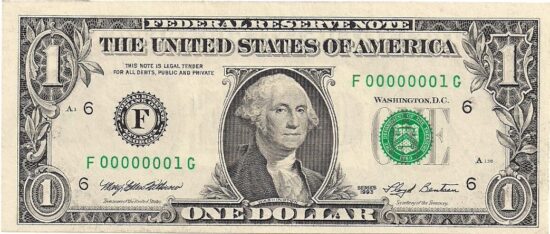 By far, the most popular type of bill that collectors want are bills with low serial numbers. Any bill with a serial number under 100 will almost always at least double the value of the bill, and sometimes make it worth much more. Collectors estimate that new $100 bills with low numbers could be worth several thousand dollars, with the serial number 00000001 bill worth $15,000.
By far, the most popular type of bill that collectors want are bills with low serial numbers. Any bill with a serial number under 100 will almost always at least double the value of the bill, and sometimes make it worth much more. Collectors estimate that new $100 bills with low numbers could be worth several thousand dollars, with the serial number 00000001 bill worth $15,000.
Since bills are created at 12 different facilities (Atlanta, Boston, Chicago, Cleveland, Dallas, Kansas City, Minneapolis, New York City, Philadelphia, Richmond VA, St. Louis and San Francisco), there are 12 different bills with each of these numbers on them. Bills with numbers under 100 are highly sought, but collectors are still interested in numbers in the hundreds, and even into the thousands. The lower the number, the more valuable it becomes.
High Numbers
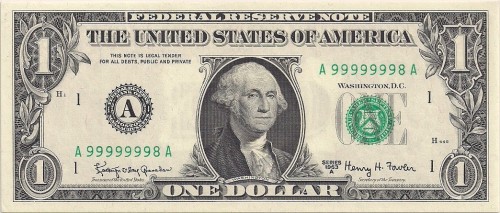 Much like the low numbers, there are also people who like to collect the high number bills. While these aren’t as popular as low number bills, it can actually be more difficult to find them. That’s because not every series of bills will reach the high numbers before they are changed – there are fewer of them that ever make it into circulation. High number serial numbers such as 99999925 or 99999853 would be coveted by collectors. The higher the number, the more valuable it becomes.
Much like the low numbers, there are also people who like to collect the high number bills. While these aren’t as popular as low number bills, it can actually be more difficult to find them. That’s because not every series of bills will reach the high numbers before they are changed – there are fewer of them that ever make it into circulation. High number serial numbers such as 99999925 or 99999853 would be coveted by collectors. The higher the number, the more valuable it becomes.
Star Notes
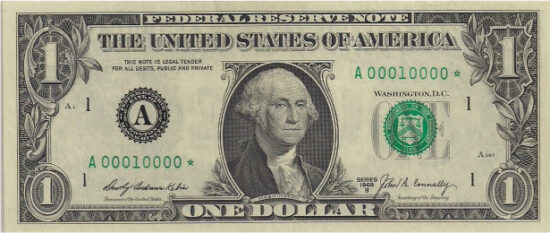 In a perfect world, nothing would ever go wrong when printing money. Since we don’t live in a perfect world, issues do arise when bills are printed. When there is some type of printing error and bills need to be printed again, it is indicated by printing a star at the end of the bill’s serial number. Since printing errors don’t happen too often, notes with a star at the end of the serial number aren’t common, and this makes them sought after by collectors. These bills are officially known as “replacement notes,” but most collectors refer to them as “star bills” or “star notes.”
In a perfect world, nothing would ever go wrong when printing money. Since we don’t live in a perfect world, issues do arise when bills are printed. When there is some type of printing error and bills need to be printed again, it is indicated by printing a star at the end of the bill’s serial number. Since printing errors don’t happen too often, notes with a star at the end of the serial number aren’t common, and this makes them sought after by collectors. These bills are officially known as “replacement notes,” but most collectors refer to them as “star bills” or “star notes.”
Ladders
Another type of bill that many collectors like to have as part of their collection are ladder bills. Ladder notes are those where the serial number ascends or descends in order. An example of an ascending ladder bill would be one with a serial number 01234567 and an example of a descending ladder note would be 98765432.
Ladder notes are rare and thus, any you find would be worth much more than its face value to collectors. It’s also possible to have a note that has both ascending and descending numbers in the same note. While this isn’t a true ladder note, it is still considered part of the ladder family and there are people who collect them. An example of this would be 34565432
Since ladder bills are so rare, people also collect “near ladder” notes. These are bills where the serial number is in a ladder sequence, but one or two aren’t. An example of this would be 51234567 or 98765430. These notes aren’t as valuable as ladder bills, but they are still worth more than the face value of the bill to collectors.
Solids
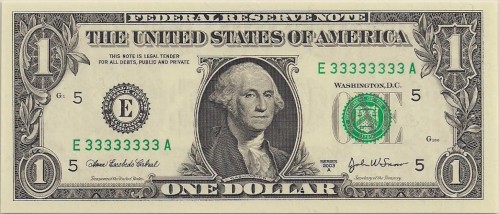 A solid note is one where the numbers are all the same for the serial number. An example of this would be a serial number of 22222222. Finding solid bills is quite rare and collectors would pay far more than face value for any that come available. Since solid notes are so rare, collectors also seek out near solid notes as well. These are bills that only have all the same number except for one digit. An example of this would be 77777797. With the near solid notes there are only two numbers in the serial number so all near solid notes are also binary notes.
A solid note is one where the numbers are all the same for the serial number. An example of this would be a serial number of 22222222. Finding solid bills is quite rare and collectors would pay far more than face value for any that come available. Since solid notes are so rare, collectors also seek out near solid notes as well. These are bills that only have all the same number except for one digit. An example of this would be 77777797. With the near solid notes there are only two numbers in the serial number so all near solid notes are also binary notes.
Repeaters
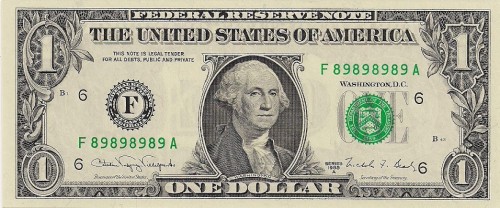 Another serial number that often attracts collectors is one that repeats the numbers in the serial number. These bills are called repeating notes or repeater notes. For example, a repeater note would be something like 48648648 or 78937893. If you can find a repeating two number bill, that is called a super repeater and is highly sought after. An example of a super repeater would be 63636363. If you find any bill that has repeating numbers constituting the serial number, it will be worth more than face value to collectors.
Another serial number that often attracts collectors is one that repeats the numbers in the serial number. These bills are called repeating notes or repeater notes. For example, a repeater note would be something like 48648648 or 78937893. If you can find a repeating two number bill, that is called a super repeater and is highly sought after. An example of a super repeater would be 63636363. If you find any bill that has repeating numbers constituting the serial number, it will be worth more than face value to collectors.
Binary & Trinary
Binary bills are those notes which have a serial number that consist of only two numbers. An example of a binary note would be 66766676. The numbers can be in any order within the serial number, and as long as there are only two different numbers it is considered a binary note. Due to the difficulty of finding binary notes, there is also demand from collectors for bills which have three different numbers in any combination. These are referred to as trinary notes, and while they’re not as valuable as binary notes, they’ll still be worth more than their face value to collectors.
True Binary
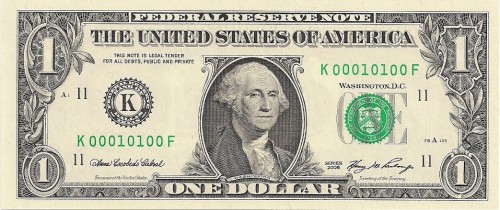 While binary bills are highly collectible, the best of the best are bills that have only ones and zeros as part of their serial number. When a bill only has ones and zeros, it is referred to as a true binary note. These notes can go for much more than other binary notes because in addition to bill collectors, you also have many computer enthusiasts who have interests in these bills. An example of a true binary would be 00011011.
While binary bills are highly collectible, the best of the best are bills that have only ones and zeros as part of their serial number. When a bill only has ones and zeros, it is referred to as a true binary note. These notes can go for much more than other binary notes because in addition to bill collectors, you also have many computer enthusiasts who have interests in these bills. An example of a true binary would be 00011011.
Birthday
A lot of people who collect bills look for bills that have special meaning to them as individuals. One of the more popular types of bills for people to collect are what are referred to as birthday notes. These are bills which have a year written somewhere within the serial number. The year usually has some special significance to the person who wants the bill such as the year they were born, an anniversary year, or the year of some other type of personal event of significance to them.
An example of a birthday note would be 65819770 where 1977 might be a significant year to someone. Another would be 00198500 where the year 1985 is significant. While the year can be anywhere within the serial number for it to be considered a birthday note, if the year comes at the very end of the serial number, or is preceded or surrounded by zeros on both sides, it is usually more desirable and therefore, more valuable to collectors.
Full Date
An even more valuable bill for collectors are full date notes. These bills have serial numbers that depict a full date rather than just a year. For example, if you were born on October 22, 1967, a full date note would read 10221967. Any note that depicts a date in full that corresponds with a special event for someone will be extremely valuable to that person, and collectors can pay quite a bit to get hold of a full date note that depicts something special for them.
Radar
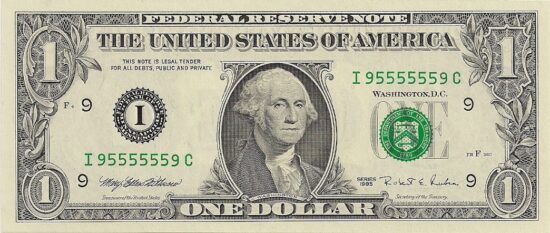 Radar bills are much like the word “radar” itself – they are bills where the serial number will read the same backwards as it does forward, just as radar reads the same both backward and forward. An example of a radar note would be 03688630 or 96255269. The serial number is the same both ways. Radar notes that are all the same except for the two end numbers are referred to as super radars. An example of a super radar would be 38888883 and these are highly sought after by collectors.
Radar bills are much like the word “radar” itself – they are bills where the serial number will read the same backwards as it does forward, just as radar reads the same both backward and forward. An example of a radar note would be 03688630 or 96255269. The serial number is the same both ways. Radar notes that are all the same except for the two end numbers are referred to as super radars. An example of a super radar would be 38888883 and these are highly sought after by collectors.
Doubles
Currency collectors are often also interested in double notes. These are bills that have the same number pair next to each other within the serial number of the bill. The most valuable of the double notes are the ones that have four distinct pairs of numbers. These are called quad doubles. An example of a quad double serial number would be 44775511 or 99003366. While the quad doubles are the most sought after, tri doubles are also valued by collectors such as 27007711, but especially if they are framed by zeros such as 07744990.
Double Quads
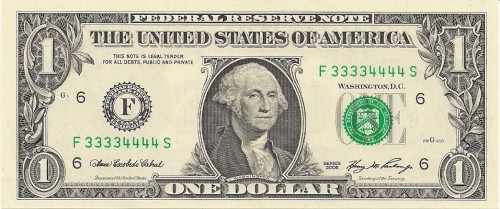 Another highly collectible bill are double quad notes. These are bills that have two sets of four of the same number. An example of this would be 44449999 or 66661111. While technically they are also a version of the quad doubles mentioned above, because they are significantly more difficult to find, they have their own name.
Another highly collectible bill are double quad notes. These are bills that have two sets of four of the same number. An example of this would be 44449999 or 66661111. While technically they are also a version of the quad doubles mentioned above, because they are significantly more difficult to find, they have their own name.
Consecutive
Consecutive notes are two (or more) bills where the serial numbers are consecutive in order. Examples of consecutive bills would be two bills in your hand with one having the serial number 97350342 and the other having 97350343. It’s actually quite easy to attain consecutive notes, as many banks have them if you get any bill denomination in a bundle of 100. Even with the ease of getting them, these are collectible and you can often get a bit more than face value for them in many instances. They become more of interest to collectors when they are consecutive and also possess one or more of the other traits mentioned in this article. For example, consecutive bills that are also a binary bills: 45554454 and 45554455.
Bookends
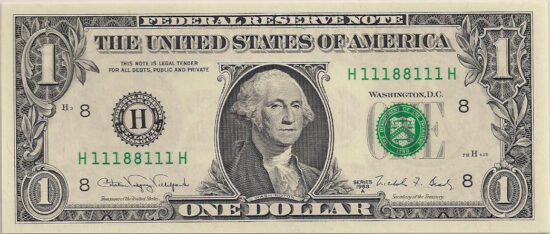 A bill’s serial number that has the same two or three numbers on each end is considered a bookend note by collectors. An example of this would be 20873420 or 34598345. Bookend notes having three numbers the same on each end are more valuable to collectors (and much more difficult to find), but even notes with two bookend numbers can fetch prices over the bill’s face value.
A bill’s serial number that has the same two or three numbers on each end is considered a bookend note by collectors. An example of this would be 20873420 or 34598345. Bookend notes having three numbers the same on each end are more valuable to collectors (and much more difficult to find), but even notes with two bookend numbers can fetch prices over the bill’s face value.
Unusual Numbers
Bank notes whose serial number matches well-known numbers also have appeal to collectors. A classic example would be a “pi” bill that had a serial number that corresponds to the first 8 digits of the numerical value of pi: 31415927. Any string of numbers that have a special meaning to someone or something will likely be coveted by some collector.
Combinations
While all of the above bills with serial numbers would likely find collectors willing to pay above face value for the bill, each gains a little more value if they are combinations of two or more of the above types of notes. While these are obviously more difficult to find than those that have just a single point of desire for collectors, combination notes also can be worth significantly more due to this rarity. One of many examples that exist would be a birthday/repeater combination which might look like 19771977.
Bonus
The reality is that if you can find something within a bill’s serial number that makes it unique, there is probably someone out there who will pay more than its face value to add it to their collection. Basically, if you look at a serial number and say to yourself, “Wow, that’s neat!” then collectors will likely feel the same way. Use the different types of bills that collectors look for mentioned above as a guide, but don’t limit yourself to them if you find an interesting serial number that isn’t mentioned.
As with all things collectible, condition matters. The better the condition of the note, the more valuable it will be. That being said, unless the bill is extremely worn and ripped, any of the above-mentioned serial numbered bills will still be worth more than their face value even if the bill has been in circulation for a while. The goal is to find the bills in the best shape possible, but don’t be discouraged if you find one of the bills that shows a bit of wear.
If you carry cash on a regular basis, a few of these notes likely pass through your hands during the year. Much like finding coins, if you simply look at the bills you have in your wallet after reading this article, you aren’t likely to find any of them. However, if you get into the habit of checking each bill that passes through your hands, you will eventually come across some that collectors desire.
Increasing Your Chances
If you are willing to take your search a step further, start withdrawing money from your bank from a teller always requesting new bills. If you do come across a bill that is collectible, it will be in better condition, making it worth more. It will also give you the chance to go back to the teller and get more bills if you get one you like with serials numbers close to any of the valuable series.
If not, the crisp bills will help you save money. As mentioned previously, this can be a fun way to make a bit of extra money that doesn’t cost a cent, since all the money that you get is still worth its face value. There aren’t many fun hobbies that let you do that.
Finally, the average lifespan of a dollar bill is between 22 and 89 months, so the chances of finding a rare or valuable bill goes down the longer the bill has been in circulation.
Where To Learn More
 A good place to learn more about dollar bills worth more than face value is to hit the books. The go-to resource in this area is the Standard Guide to Small-Size U.S. Paper Money – 1928-Date (Standard Catalog)
A good place to learn more about dollar bills worth more than face value is to hit the books. The go-to resource in this area is the Standard Guide to Small-Size U.S. Paper Money – 1928-Date (Standard Catalog). This resource is particularly useful for identifying which block letters and serial numbers are potentially valuable. You can pick up a used copy on Amazon.com for cheap – just five or six bucks.
(Photos Credit: CoolSerialNumbers)
Jeffrey strain is a freelance author, his work has appeared at The Street.com and seekingalpha.com. In addition to having authored thousands of articles, Jeffrey is a former resident of Japan, former owner of Savingadvice.com and a professional digital nomad.


















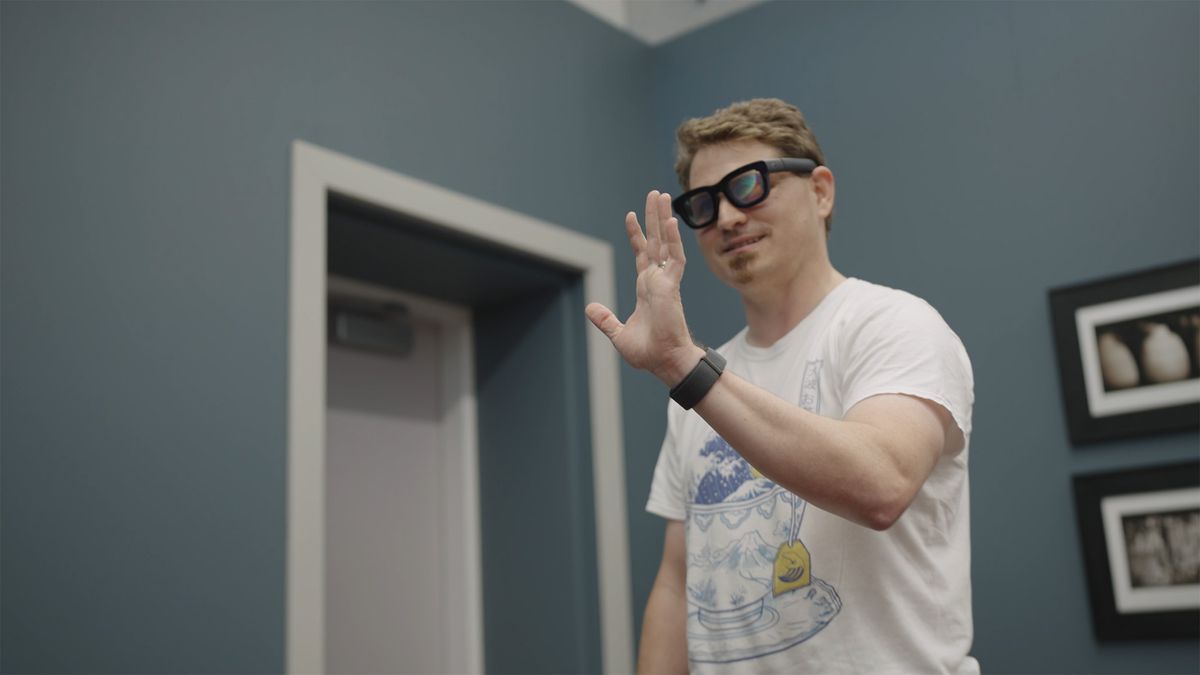

Discussion about this post